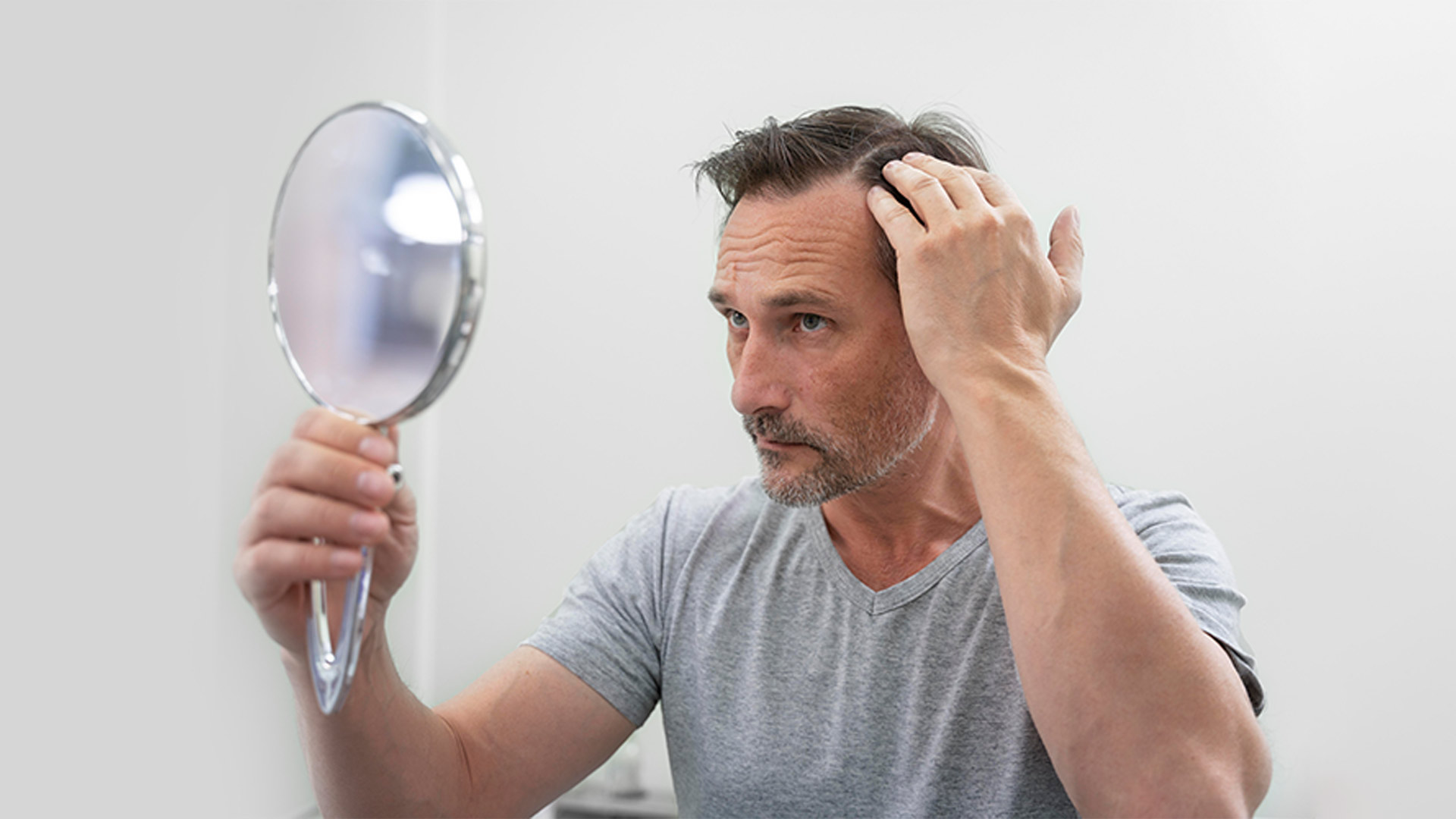Accepting Most Major Insurances for Treatment Appointments
Receding Hairline:
A Race Against Time.
Receding hairline is a common hair loss pattern that occurs to a greater extent in men than in women. According to a research study, the condition is prevalent in 67.1% of men and only 23.9% of women.
While a receding hairline, in both men and women, is commonly linked to aging but younger people may also experience it.
How to Fix Receding Hairline?
Understanding the causes of your hair’s receding hairline can contribute heavily to preventing it. This will allow you to eliminate the problem from its root – literally. This is why a good chunk of this article has been dedicated to giving you, the reader, a thorough understanding of what causes a receding hairline. Hope it helps!
Receding Hairline in Men:

Your doctor might advise a scalp biopsy if you are losing hair without a known reason. Your medical professional may benefit from a scalp biopsy if:
- Mature hairline: This is a normal part of aging and typically occurs in men in their late 20s to early 30s. The hairline recedes slightly, creating a more pronounced "M" shape, but hair loss is usually minimal.
- Widow's peak: This is where the hairline recedes at the temples. It creates a distinctive “V” shape in the center of the forehead.
- Uneven hairline: This type of receding hairline is characterized by uneven hair loss. In this condition, one side of the hairline recedes more than the other.
The Norwood Scale:
The Norwood scale is a classification system that is used to classify male pattern baldness. There are seven stages in total, with each stage representing a different degree of hair loss.
What Causes a Receding Hairline in Men?
- Androgenetic Alopecia: This is the most common cause of hair loss in men, also known as male pattern baldness. It is hereditary and caused by a combination of genetics and male hormones. It causes the hair follicles to shrink leading to a receding hairline and balding on the crown of the head.
- Hormonal Changes: Hormonal changes, such as those that occur during puberty, can cause a temporary receding hairline in young men. Hormonal changes can also occur due to health conditions, such as thyroid problems or testosterone imbalances.
- Medications: Certain medications, such as chemotherapy drugs, steroids, and some antidepressants, can cause a receding hairline in men.
- Medical conditions: Some medical conditions, such as autoimmune disorders or scalp infections, can cause hair loss in men.
Receding Hairline in Women:

- Female Pattern Baldness: Female pattern baldness differs from male pattern baldness. Usually, females do not experience a receding hairline from the front of the scalp. They commonly experience hair thinning and hair loss from the top or crown of the head.
- Frontal Fibrosing Alopecia: It is a type of scarring hair loss that mainly affects the hairline and forehead. It's more commonly seen in postmenopausal women. But it can also affect premenopausal women and men as well. Frontal Fibrosing Alopecia is an autoimmune disorder, in which the immune system attacks the hair follicles and leads to scarring and permanent hair loss. The exact cause of the condition is unknown, but it's believed to be related to hormonal and genetic factors.
What Causes a Receding Hairline in Women?
Although receding hairline is more common in men, in women certain conditions cause the hairline to recede:
- Nutritional Deficiencies: Some nutritional deficiencies such as iron or biotin deficiency causes receding hairline in women.
- Medical Conditions: Certain medical conditions like autoimmune disorders, scalp infections, or thyroid disorders causes hairline recession.
- Androgenetic Alopecia: This is the most common cause of hair loss in women and is characterized by a receding hairline, and hair thinning.
- Hormonal Imbalances: Changes in hormone levels, such as those that occur during pregnancy, menopause, or as a result of a medical condition like polycystic ovary syndrome (PCOS), or miscarriage can lead to a receding hairline in women.
- Traction Alopecia: This type of hair loss is caused by repeated pulling or tension on the hair. It often occurs due to tight hairstyles such as braids or ponytails. It can cause a receding hairline along the front of the scalp. Overuse of certain hairstyling techniques, such as frequent blow drying, curling, or hairsprays, results in a receding hairline.
Telogen Effluvium:
Stress and anxiety or emotional distress are the biggest causes of alopecia. The condition is referred to as Telogen Effluvium. Stress-induced Alopecia causes a bunch of hair to fall out every time they are combed or shampooed. Telogen Effluvium is not noticeable until the stressful event is over, the condition takes up to 8 months to subside. Although it is a temporary condition, it can become chronic in some cases.
What are the Symptoms of a Receding Hairline?
In some cases, you will start to notice thinning of the hair in pictures, or your hair will start to act differently.
- Thinning Hair: The hair around the temples and forehead may appear thinner than the rest of the hair on the scalp.
- Widening Part: The part in the hair may appear wider than before due to thinning hair.
- Bald Patches: In some cases, a receding hairline can lead to small bald patches around the temples and forehead.
- Itching Or Burning Scalp: Some people may experience itching or burning sensations on the scalp due to hair loss.
- Losing More Hair Than Usual: You will start to notice breakage of hair than it usually did before.
How to Stop Receding Hairline?
Some of the ways you can stop your hairline from receding in the early stages include:
- Take care of your hair: Avoid pulling or tugging on your hair, as this can damage the follicles and lead to further hair loss. Also, avoid tight hairstyles like weaves or braids, as these can put too much pressure on your scalp. Avoid using too many hair products, hot ironing, and curling.
- Eat a balanced diet: Make sure your diet includes plenty of protein, vitamins, and minerals, as these are essential for healthy hair growth. Good sources of these nutrients include lean meats, fish, eggs, nuts, fruits, and vegetables.
- Manage stress: Stress contributes to hair loss, so finding ways to manage stress, such as meditation or exercise, helps.
- Consider hair loss treatments: There are several hair loss treatments available, including over-the-counter products. These treatments may help slow down or even reverse hair loss in some cases.
- Talk to a doctor: If your hair loss is severe or you're concerned about it, book an appointment with a Doctor or dermatologist. They can help determine the underlying cause of your hair loss and recommend appropriate treatments.
How is a Receding Hairline Treated?
Multiple therapies can help you fix receding hairline or treat it completely:
Medications:
Some oral medications help treat receding hairline. Prescription medications like Finasteride lower the hormones that are responsible for hair loss and hairline recession. It is known to promote hair growth and stop hair fall.
Topical medications such as Minoxidil are being used as an off-label treatment for receding hairline. It has shown good results in over 40% of the people who have been treated by it.
Hair Transplant:
A hair transplant is a cosmetic procedure. It involves taking the hair follicles from a donor site (usually from the back of your head) and transplanting them to the front. This helps give a fuller hair look. This procedure is usually done on men who have male pattern baldness.
Platelet-Rich Plasma Therapy:
Platelet-rich plasma therapy or PRP is a medical procedure that is used to promote hair growth. In this procedure, blood is drawn from a patient’s arm and processed in a centrifuge machine. Centrifugation segregates the platelets from other blood components. These segregated platelets are then injected into the scalp to rejuvenate the hair follicles.
Low-Level Light Therapy:
Low-level light therapy is also known as photobiomodulation or cold laser therapy. It is a non-invasive medical treatment that involves the use of low-level light to stimulate cellular activity. It is known to start the “Anagen” phase within the cells.
Impact of Receding Hairline on Psychology:
A receding hairline has a major impact on an individual’s psychology, especially for men. Some of the ways that it can affect a person’s psychological well-being:
- Self-Esteem: A receding hairline can negatively impact an individual's self-esteem and self-confidence. It can make them feel less attractive and lead to feelings of insecurity.
- Body Image: It can affect an individual's body image and make them feel less desirable. It can lead to negative body image issues and even affect their overall perception of themselves.
- Social Anxiety: A receding hairline can also lead to social anxiety and makes an individual feel uncomfortable in social situations. They may feel like they are being judged or that others are noticing their hair loss.
- Depression: Individuals with hair loss may experience depression, as they may feel less attractive and less confident in themselves. This can lead to feelings of hopelessness and lack of motivation.
Bottom line:
In conclusion, receding hairline has not only been a concern for men, but it has also vastly affected women. The major cause of Alopecia in men is known to be male pattern baldness. Whereas, in women, it is due to frontal fibrosing and scarring. Although it is a treatable condition, the hairline recession still has caused severe social anxieties. It causes lowered self-esteem and depression among people of both genders.
